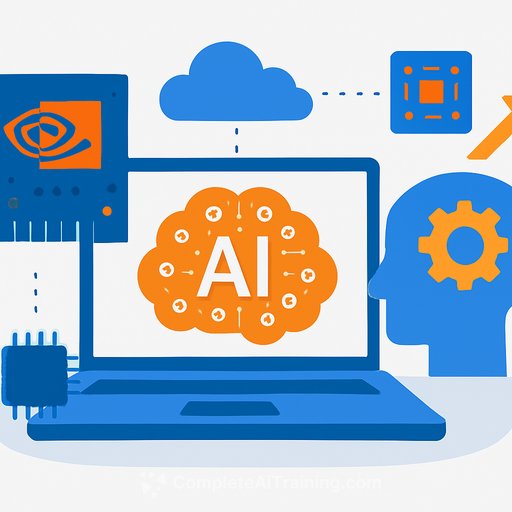A Platform, Not a Product: Why Nvidia Is Becoming AI's Operating System
Jensen Huang didn't pitch chips. He outlined an infrastructure layer. His message was simple: Nvidia isn't just selling GPUs; it's building the platform that runs every meaningful AI model and sits inside every major cloud.
For managers, that shift changes how you plan budgets, talent, and partnerships. You're not picking components anymore. You're choosing an operating base for your entire AI stack.
From components to platform
Nvidia's edge isn't only performance. It's the flywheel: CUDA, libraries, frameworks, compilers, networking, and systems software that keep teams productive and workloads portable across generations of hardware.
Hardware adoption drives software support; software support drives hardware demand. Over time, that creates switching costs. Not just for engineers-but for your roadmap.
Every cloud. Every model. Everywhere.
Nvidia's stack shows up across hyperscalers and model providers. Whether you're experimenting with models from OpenAI, Anthropic, xAI, or Google's Gemini, your teams likely touch the same underlying platform.
Enterprises prefer one stack that can run many models without building separate optimization paths. That preference is pragmatic: less integration work, fewer surprises in production, and a cleaner operating model.
What this means for your roadmap
- Standardize on a primary platform. Pick the default path for training, fine-tuning, and inference. Reduce sprawl.
- Plan for lock-in and portability. Define where you accept dependency (CUDA, libraries) and where you maintain optionality (containers, orchestration, data formats).
- Build a multi-cloud playbook. Same images, same pipelines, same monitoring across providers to avoid rework.
- Shift budgets to AI infrastructure and MLOps. Treat it like core IT, not side projects.
- Invest in team fluency. Your engineers should know accelerators, memory constraints, and cost/performance trade-offs.
- Treat data as the performance bottleneck. Design your data pipelines, caching, and retrieval with the model plan in mind.
For investors and executives: momentum plus lock-in
Huang's key signal: customers who tried alternatives are coming back, and that flow is increasing. That isn't just demand-it's consolidation around a standard.
When a vendor becomes the default operating layer, replacement cycles stretch. That informs how you evaluate suppliers, negotiate contracts, and pace risk-taking.
Operational checklist for the next 12 months
- Define your "AI base image": CUDA version, drivers, libraries, container standards, and observability tools.
- Create a capacity plan. Map model sizes, concurrency, and latency targets to GPU classes and networking needs.
- Set a second-source policy. Know which workloads could move to alternative accelerators and what that would cost in time and quality.
- Align model strategy. Decide when to use foundation APIs, open models, or custom fine-tuning-and the governance behind each.
- Track ROI per workload. Tie spend to business metrics (CSAT, lead conversion, defect reduction, cycle time), not vanity benchmarks.
- Negotiate platform-level agreements. Think beyond instances: software stack, support, priority access, and training credits.
Questions to ask your team and vendors
- What's our standard stack for training, fine-tuning, inference, and monitoring? Who owns versioning?
- How portable are our workloads across clouds today? What breaks if we switch regions or providers?
- Where do we accept vendor-specific features for speed, and where do we keep abstraction for control?
- What's our plan for data movement, retrieval, and security across model types?
- How are we measuring cost per token, per request, and per business outcome?
Why this matters now
The market is moving from experimentation to enterprise deployment. That move rewards a single, consistent platform that can run "every model, everywhere" with predictable behavior and support.
Managers who codify standards early will ship faster and spend less. Those who don't will pay the tax of fragmentation-duplicate tooling, slow incident response, and confused ownership.
Useful resources
- NVIDIA CUDA overview for understanding the software layer your teams build on.
- NVIDIA Investor Relations for platform and data center strategy updates.
- AI training by job role to upskill managers and technical leads on practical AI adoption.
Bottom line
Nvidia is positioning itself as the operating system of AI. Plan your architecture, skills, and contracts around that reality-and keep a clear escape hatch where it matters.
Disclosure: This article is for general information and is based on publicly available sources. We aim for accuracy but cannot guarantee it. Views are those of the author and may not reflect those of the publication. Some content was assisted by AI and reviewed by a human for clarity. We encourage readers to verify key details. This article may include affiliate links; if you purchase through them, we may earn a small commission at no extra cost to you.
Your membership also unlocks:






